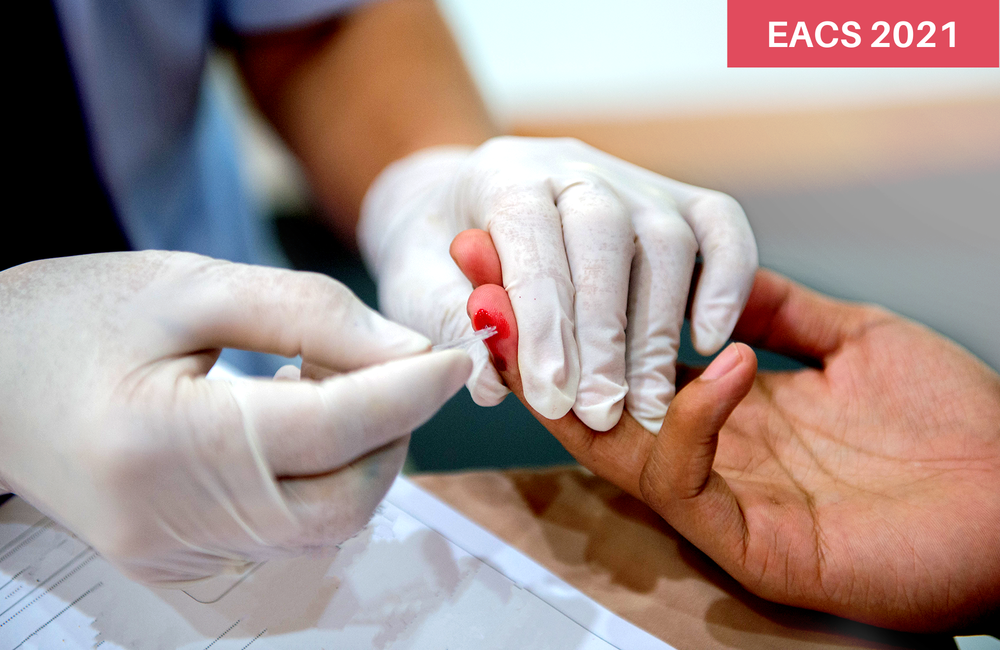
More widespread HIV testing in Europe is being hampered by medical guidelines which do not recommend testing people who have AIDS-defining conditions or other illnesses that could be linked to HIV, the 18th European AIDS Conference (EACS 2021) heard today.
In order to achieve the first of UNAIDS’ 95-95-95 goals – in which 95% of people living with HIV have been diagnosed – HIV testing programmes increasingly need to reach individuals who are not viewed as belonging to a risk group for HIV or who do not see themselves as at risk, but who may nonetheless have HIV.
One way to achieve this is through testing of people with ‘indicator conditions’. For the past decade, European HIV testing guidelines have recommended that non-HIV physicians offer HIV tests to patients who present to medical care with a condition:
- that is AIDS-defining in the presence of HIV – such as cervical cancer, tuberculosis or Pneumocystis carinii pneumonia (PCP)
- that is associated with an increased prevalence of undiagnosed HIV (over 1 in 1000) – such as sexually transmitted infections, unexplained fever or unexplained low platelets (thrombocytopenia)
- where an underlying HIV infection would have significant implications for how the condition should be managed – such as a cancer or a transplant requiring immunosuppressive therapy.
Implementation by healthcare professionals working in other specialities remains limited. HIV and infectious disease clinicians have usually seen first-hand the clinical consequences of missed testing opportunities and of late HIV diagnosis, whereas their colleagues working in other specialities may not be aware of recommendations and have other priorities.
Local projects have had positive results through education and training, simplifying testing procedures (such as opt-out consent and digital prompts for clinicians), involving non-HIV specialists in implementation research, and collaborating with HIV services to provide support to manage indeterminate or reactive test results.
An important barrier remains the large number of medical guidelines which do not mention HIV testing or don’t recommend it. At EACS 2021, Dr Carlijn Jordans of Erasmus University reviewed 786 national speciality guidelines that cover 63 HIV indicator conditions in 13 European countries.
Only 65% of guidelines made any mention of HIV testing and only 44% actually recommended it. Even in guidelines covering AIDS-defining conditions, only 50% recommended HIV testing.
Guidelines from eastern European countries were actually more likely to recommend testing than those from western European countries. The study covered seven western European countries (the Netherlands, United Kingdom, Belgium, Italy, Switzerland, Germany and Greece) and six in eastern Europe (Lithuania, Poland, Romania, Russia, Ukraine and Belarus).
Some indicator conditions had particularly poor coverage. Among the AIDS-defining conditions, these included cervical cancer (15% of guidelines), recurrent pneumonia (18%), cytomegalovirus (25%) and candidiasis (33%). Among other conditions, they were community-acquired pneumonia (8%), peripheral neuropathy (8%), lung cancer (9%) and cervical dysplasia (10%).
By speciality, the guidelines most likely to recommend HIV testing covered haematology (blood disease and malignancies), sexual health, and dermatology (skin conditions).
The findings add to those from a systematic review earlier this year, which looked for all available reports on the uptake of HIV testing in seven indicator conditions in high-income countries. The uptake of testing was highest in patients with tuberculosis (72%), but lower in those with hepatitis C (49%), hepatitis B (45%), lymphoma (35%) or cervical cancer or pre-cancer (12%). The researchers couldn’t find any data on HIV testing in the context of peripheral neuropathy, or of vulvar cancer or pre-cancer.
But they did find that when testing was performed, the proportion of patients who tested positive for HIV was usually high enough to show its value – 5% of those with tuberculosis, 4% of those with viral hepatitis and 1% of those with lymphoma.
Jordans CCE et al. A European review of HIV testing recommendations in national specialty guidelines for the management of HIV indicator conditions. 18th European AIDS Conference, London, abstract OS3/1, 2021.
View the abstract on the conference website.
Update: Following the conference presentation, this research was published in a peer-reviewed journal:
Jordans CCE et al. National medical specialty guidelines of HIV indicator conditions in Europe lack adequate HIV testing recommendations: a systematic guideline review. Eurosurveillance, 27: 2200338, December 2022.
https://doi.org/10.2807/1560-7917.ES.2022.27.48.2200338
Bogers SJ et al. Current evidence on the adoption of indicator condition guided testing for HIV in western countries: A systematic review and meta-analysis. eClinical Medicine 35: 100877, 2021 (open access).
